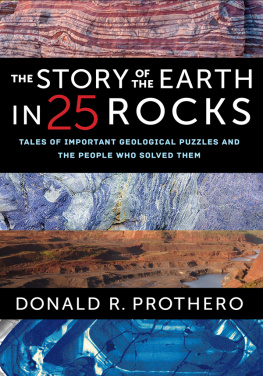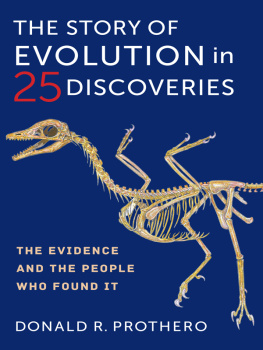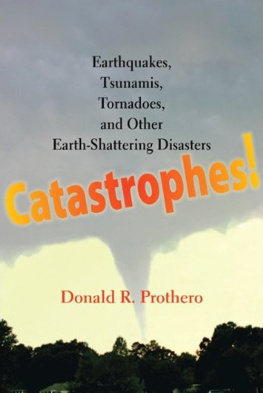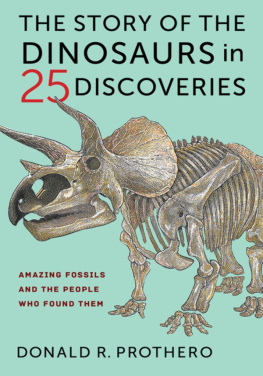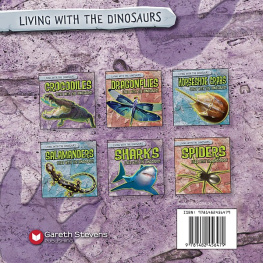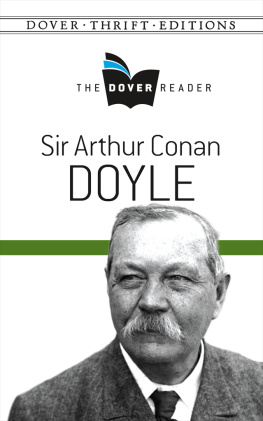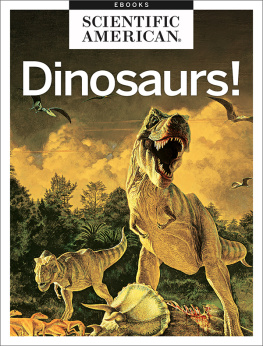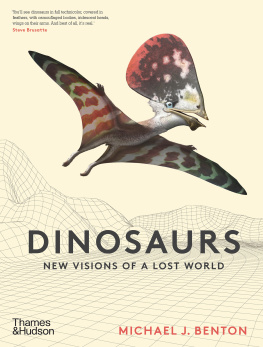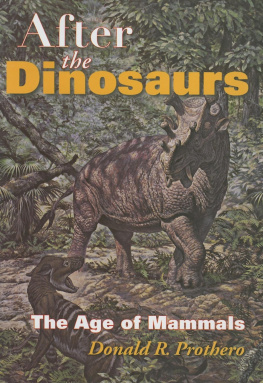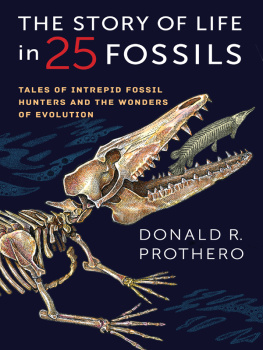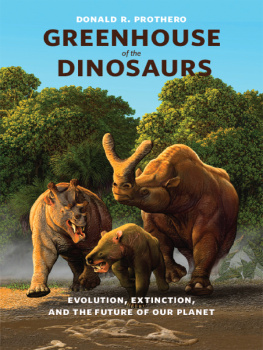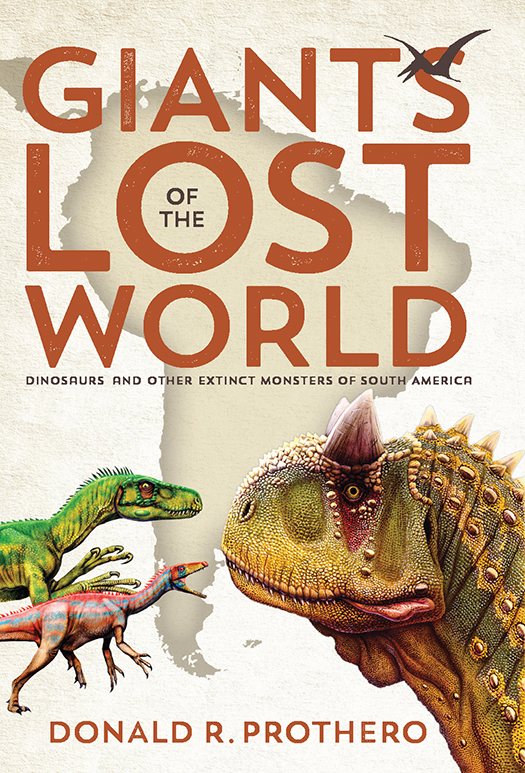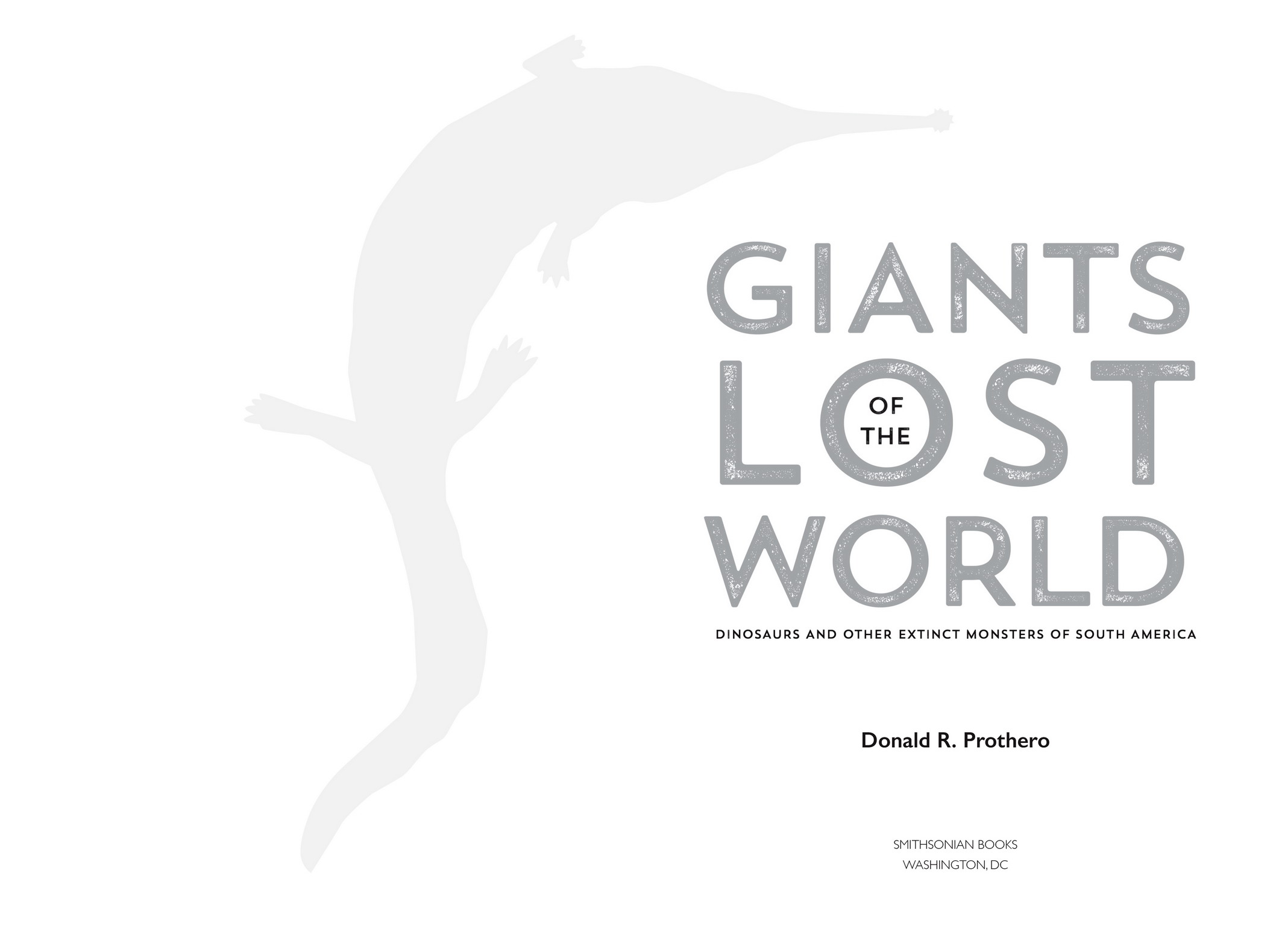Text 2016 by Donald R. Prothero
All rights reserved. No part of this publication may be reproduced or transmitted in any form or by any means, electronic or mechanical, including photocopying, recording, or information storage or retrieval system, without permission in writing from the publishers.
Published by Smithsonian Books
Director: Carolyn Gleason
Managing Editor: Christina Wiginton
Production Editor: Laura Harger
Editorial Assistant: Jaime Schwender
Edited by Gregory McNamee
Designed by Gary Tooth
Library of Congress Cataloging-in-Publication Data
Prothero, Donald R.
Giants of the lost world : dinosaurs and other extinct monsters of South America / by Donald R. Prothero.
Other titles: Lost world | Dinosaurs and other extinct monsters of South America
Description: Washington, D.C. : Smithsonian Books, [2016] | Includes index.
Identifiers: LCCN 2015047514 | ISBN 9781588345738
Ebook ISBN: 978-1-58834-574-5
Subjects: LCSH: DinosaursSouth America. | Extinct animalsSouth America. | Doyle, Arthur Conan, 18591930. Lost world.
Classification: LCC QE861.9.S68 P76 2016 | DDC 567.9098dc23
LC record available at http://lccn.loc.gov/2015047514
For permission to reproduce illustrations appearing in this book, please correspond directly with the owners of the works, as seen at the end of the figure caption. Smithsonian Books does not retain reproduction rights for these images individually or maintain a file of addresses for sources.
v3.1
Dedicated to the pioneers of South American paleozoology
Georges Cuvier
Charles Darwin
Alfred Russel Wallace
Peter Wilhelm Lund
Florentino and Carlos Ameghino
John Bell Hatcher
William Berryman Scott
George Gaylord Simpson
Jos Bonaparte
Carlos de Paula Couto
Rosendo Pascual
without whom this story would never be known
CONTENTS
Figure 0.1. Sir Arthur Conan Doyle, author of the Sherlock Holmes detective stories and The Lost World.
INTRODUCTION
The Lost World
The Lost World was a work of fiction by Sir Arthur Conan Doyle, the author of the Sherlock Holmes stories, but it was based on the newly made discovery of actual isolated plateaus in the Amazonian jungles of South America inhabited by unique creatures unknown to science. Not even Doyle could have imagined the extinct gigantic creatures that really did exist in the prehistoric past of South America.
Sherlock Holmes just wouldnt die.
His creator, Sir Arthur Conan Doyle (), had written the first short story about the legendary detective back in 1886. By 1893, he had written twenty-four short stories and two novels. He was tired of the task of churning out several Holmes stories a year for Strand Magazine. Like many a writer with one very successful book series, Conan Doyle was afraid of being typecast as the author of Sherlock Holmes and nothing else. He wanted to work on historical fiction instead. In November 1891, he had written to his mother, I think of slaying Holmes and winding him up for good and all. He takes my mind from better things. His mother wrote back, You wont! You cant! You mustnt! But in 1893, he published The Final Problem, in which Holmes and his nemesis, Dr. Moriarty, fight to the death at Reichenbach Falls and Holmes falls to his doomor so it appears.
When readers cried out for more Sherlock Holmes stories, Conan Doyle realized that he had underestimated the popularity of his most famous character. In addition, his other writings did not sell very well. After an eight-year hiatus, he relented and wrote The Hound of the Baskervilles, the most famous Holmes story ever. In 1903, Conan Doyle brought the short stories back again with The Adventure of the Empty House. In this story, Holmes reveals that he escaped the fall that killed Moriarty but had to remain in hiding for a year to flush out his henchman, Colonel Sebastian Moran, whom Holmes caught trying to assassinate him. Conan Doyle then dutifully wrote thirty-two more Sherlock Holmes stories and one more novel until 1927, three years before his death at age seventy-one, never again daring to alienate his loyal readers.
In 1911, though, Conan Doyle got an inspiration for a story and a character that might compete for popularity with Sherlock Holmes. He heard a lecture on February 11 at the Royal Geographical Society about the Huanchaca Plateau in Bolivia given by a good friend of his, the noted explorer Percy Harrison Fawcett. Fawcett was famous for his perilous expeditions in South America, where he nearly starved to death more than once. Many of the fearless explorers featured in the comic books and adventure movies of the 1950s were based on Fawcett. These, in turn, may have been the inspiration for popular modern movie characters such as Allan Quatermain and Indiana Jones.
As Fawcett wrote in his posthumous memoirs,
Monsters from the dawn of mans existence might still roam these heights unchallenged, imprisoned and protected by unscalable cliffs. So thought Conan Doyle when later in London I spoke of these hills and showed photographs of them. He mentioned an idea for a novel on Central South America and asked for information, which I told him I should be glad to supply. The fruit of it was his Lost World in 1912, appearing as a serial in the Strand Magazine, and subsequently in the form of a book that achieved widespread popularity.
Conan Doyle was influenced not only by Fawcetts discoveries but also by the first blooming of dinomania. Although fragmentary dinosaur fossils had been found in England as early as 1824, they were too incomplete to build a complete skeleton. Except for some large lizardlike models sculpted by Waterhouse Hawkins for the Great Exhibition of 1851, there were few reconstructions or images of dinosaurs available for public consumption, since the fossils were too piecemeal. Most of them were just a few bones, not enough to even to grasp their enormousness. So far, dinosaurs had still not made much of a dent in the public consciousness.
At the beginning of the twentieth century, however, museums in the United States began to mount large skeletons of dinosaurs, such as Brontosaurus (now Apatosaurus), Stegosaurus, Allosaurus, Triceratops, and Tyrannosaurus rex, that had been recently found in Colorado, Wyoming, and Montana. They also commissioned paintings and sculptures of these beasts, giving people an image of dinosaur for the very first time. Soon dinosaurs were a huge fad and their images were everywhere, and the phrases as dead as a dinosaur and like a dinosaur entered the public language as well.
The lucky accident of hearing Fawcetts accounts, combined with the popularity of dinosaurs in the public imagination, gave Conan Doyle an idea for a story. In 1912, he published a novel entitled The Lost World, in which dinosaurs still survive on an isolated plateau in South America, forgotten by time. The featured dinosaurs are those known to science at the time: Iguanodon and Megalosaurus


